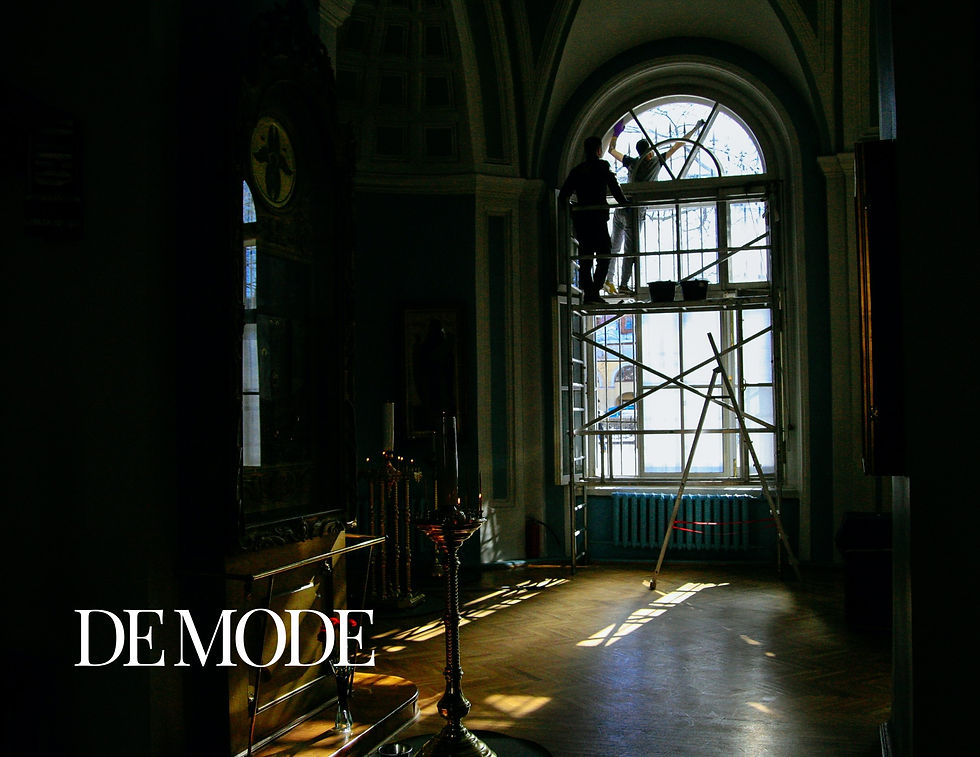"THE ART OF CONSERVATION - PRESERVING CULTURAL HERITAGE THROUGH RESTORATION": DE MODE GLOBAL
- DE MODE

- Jul 7, 2023
- 3 min read
ORIGINALLY PUBLISHED IN DE MODE
Article Published on: 07TH JULY 2023 | www.demodemagazine.com
Cultural heritage is a testament to the rich tapestry of human history, encompassing artworks, monuments, artifacts, and structures that hold deep cultural, historical, and artistic significance. However, the passage of time, environmental factors, and human activities can take a toll on these precious treasures, endangering their integrity and threatening their existence. Restoration, as a form of art in itself, plays a crucial role in preserving our cultural heritage, ensuring that these treasures can be passed on to future generations.
Restoration is a meticulous and interdisciplinary process that aims to repair, conserve, and preserve cultural heritage. It combines scientific knowledge, artistic skill, and a deep understanding of historical context to breathe new life into deteriorated artworks and structures. Through restoration, we not only salvage physical objects but also preserve the stories, traditions, and identities they embody.

One of the primary goals of restoration is to return an artwork or structure as closely as possible to its original condition. This requires a comprehensive understanding of the artist's intent, the materials used, and the historical context in which it was created. Restorers analyze the structure, composition, and deterioration patterns to develop a conservation plan that addresses both the aesthetic and structural aspects of the object.
Restoration often involves intricate processes such as cleaning, stabilizing, repairing, and reconstructing damaged or missing parts. The choice of materials and techniques is crucial to ensure that the restoration is reversible, respectful of the original work, and compatible with the aging process of the object. Restorers must strike a delicate balance between preserving the original material and introducing necessary interventions to ensure the longevity of the artwork or structure. Art conservation also requires a multidisciplinary approach, involving collaborations between conservators, art historians, scientists, and other experts. Analytical techniques such as spectroscopy, microscopy, and imaging technologies play a vital role in examining the materials, pigments, and structures of artworks, helping to unravel their history and aid in the decision-making process. By combining scientific analysis with artistic expertise, conservators can make informed choices about the most appropriate treatment and conservation strategies.
Restoration is not limited to individual artworks. It extends to larger architectural structures, historical sites, and cultural landscapes. Buildings, monuments, and archaeological sites carry the imprint of past civilizations and bear witness to human achievements and cultural identity. By restoring these structures, we preserve not only their physical form but also the narratives and memories they hold.

The restoration of architectural heritage requires a comprehensive understanding of architectural principles, construction techniques, and historical research. It involves preserving the original design intent while addressing structural issues, weathering, and decay. This process often includes stabilizing foundations, repairing damaged elements, and implementing preventive measures to safeguard against future deterioration.
Beyond the technical aspects, restoration has significant social and cultural implications. It fosters a sense of pride and ownership among communities, reinforcing their cultural identity and heritage. The restoration of cultural sites and artworks also has the potential to stimulate tourism, contribute to local economies, and provide educational opportunities for visitors and locals alike. Furthermore, it allows for the transmission of traditional craftsmanship skills, ensuring that these techniques are not lost to time.
Restoration efforts can be seen worldwide, preserving cultural heritage in various forms. For instance, the restoration of the Sistine Chapel in the Vatican involved painstaking cleaning and conservation of Michelangelo's frescoes, revealing vibrant colors and intricate details that had been obscured by centuries of dirt and grime. This restoration allowed future generations to appreciate the mastery of the artist and the significance of this iconic cultural treasure.

In Venice, ongoing efforts to conserve the city's historic buildings and canals are vital to protect the unique architectural ensemble and combat the challenges posed by rising sea levels and urbanization. Restoration projects, such as the ongoing work on the Rialto Bridge, not only preserve the city's architectural heritage but also ensure the continuation of Venetian craftsmanship traditions.
In conclusion, the art of conservation through restoration plays a vital role in preserving our cultural heritage. It requires a delicate balance of scientific analysis, artistic skill, and historical understanding to safeguard precious artworks, structures, and cultural sites. Through restoration, we ensure that future generations can appreciate and learn from the legacy of our ancestors. As custodians of cultural heritage, we have a responsibility to protect and preserve these treasures, allowing them to continue to inspire, educate, and captivate audiences for centuries to come.



Comments